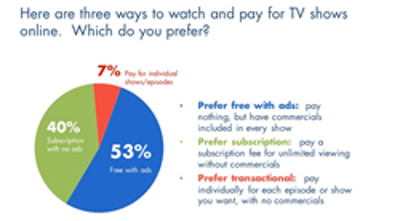TV viewers would rather watch ad-supported online TV than pay for a subscription
Tuesday, September 27th, 2016
New research from Hub Entertainment Research shows that most TV viewers would rather watch ad-supported online TV than pay for a subscription
- But if technology gives them the ability to skip those ads, they’ll use it
BOSTON, MA — The online TV market appears to be settling on monthly or yearly subscriptions as its pay model of choice. One example: Hulu’s recent decision to discontinue it’s “free-with-ads” service and focus solely on it’s paid subscription tiers.

But in a new study from Hub, a majority of TV consumers (53%) say they actually prefer free TV, where they “pay” by viewing commercials.
However, the way viewers respond to ads themselves seems to run counter to this stated preference. In fact, majorities of TV viewers say they skip ads whenever they have the chance:
- More than 8 in 10 (83%) of DVR users skip ads at least “most of the time”. That includes 60% who say they skip every ad.
- Two-thirds (68%) of DVR users say they will at least “sometimes” pause their DVR at the beginning of a live broadcast, so they can fast forward through ads. One-quarter (26%) say they do this “every time”.
- Majorities (52% to 56%) skip ads “most” or “every time” on VOD and online platforms, when fast forward is available.
What’s more, when fast forward has been disabled on a TV platform, many TV viewers see that as more than just a minor annoyance.
- Nearly half (45%) say that fast forward disabling is a “major frustration”.
What consumers seem to be saying is that ad supported TV is still an appealing pay model, but the way ads are incorporated into online TV disrupt the experience and make alternative platforms more appealing. The survey tested a number of ideas for making ads in TV content more engaging. Consumers had the most positive reaction to three strategies:
- Lighter ad loads: One ad per ad pod (rated as a 9.3 in terms of likelihood to pay attention to ads)[1] was the highest rated idea tested.
- Targeting ads based on relevance or product interest: Ads more relevant to my interests (8.1), fewer ads but more targeted to me personally (7.1), and ads shown based on product categories I choose in advance (5.9) all scored higher than average.
- Gamifying the ad experience: Earn points for watching ads (8.2), earn promo codes for watching ads (7.3), and include countdown clock for when the show will resume (5.9) also received strongly positive scores.
“Conventional wisdom says that consumers simply don’t like ads on TV. But what our study suggests is that they don’t like the way ads are delivered on TV,” said Peter Fondulas, Principal at Hub. “Consumers say they’d welcome having ads more targeted to their interests and product needs. And what’s especially interesting is that better targeting of ads based on past purchases doesn’t appear to raise major privacy concerns.”
“Some networks have already started down the path of reducing ad loads on TV, but making the ads themselves more relevant to the individual viewer is a tool that will make ad-supported TV more effective for advertisers, and more enjoyable for consumers”,” said Jon Giegengack, Principal at Hub.
Latest News
- Tata Motors selects HARMAN Automotive's in-vehicle app store
- Media Distillery to power Swisscom ad-free replay product
- MagentaTV strengthens addressable TV business with Equativ
- Deutsche Telekom selects Broadpeak Cloud DVR solution for MagentaTV
- Nexxen empowers Australian advertisers using VIDAA ACR data
- TargetVideo integrates AI for video content categorization